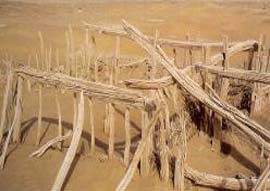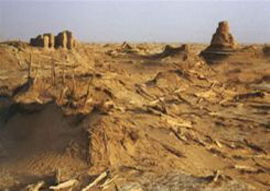The Southern Silk Road followed the northern foothills of the Kunlun Mountains and skirted the  southern edge of the Taklamakan to Kashgar where the Northern and Southern Silk Roads merge. Approximately half way between Korla and Kashgar is the modern, fly blown oasis town of New Niya (Minfeng). southern edge of the Taklamakan to Kashgar where the Northern and Southern Silk Roads merge. Approximately half way between Korla and Kashgar is the modern, fly blown oasis town of New Niya (Minfeng).
Long, long ago there was a king. He had 300 soldiers, 3,000 residents in his state and one gold camel, which was his dearest possession. But he fell in love with a woman who was also loved by the king of another state, and thus a war was started. God, angered by the war, blew up a black sandstorm that lasted for 80 days and buried the entire kingdom, including the gold camel.
More than 2,000 years later, in 1901, the British explorer Marc Aurel Stein came upon the ruins of the  kingdom far out in the desert, and the world then heard for the first time the name of Niya, as dreamlike as the Uygur legend you have just read. kingdom far out in the desert, and the world then heard for the first time the name of Niya, as dreamlike as the Uygur legend you have just read.
Niya, believed to have flourished from the 1st century BC to the 4th century, has remained the best preserved and one of the largest ruins of the city states that were scattered along the ancient Silk Road about 1,500 years ago. It became known as the Pompeii of the Silk Road.
As late as the 1960s it still took 40 days to travel from New Niya to Korla but the completion of the new Desert Highway built to facilitate the exploitation of Xinjiang's vast oil reserves means that the journey can now be completed in about 8 hours. The drivers of the trucks that now race through New Niya are probably oblivious to the fact that they are traversing a region that was once one of the richest kingdoms along the Silk Road. |
